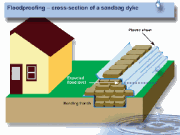The most common emergency floodproofing technique entails stacking sandbags in such a way as to form a barrier against rising floodwaters. The bags must be strong enough to hold the sand or fill and withstand contact with water indefinitely. It is best to use burlap and plastic bags designed for that purpose and to use a durable plastic sheet to prevent the seepage of water through the dike.
Since water exerts pressures against the sandbag dike, if at all possible a trench should be dug to prevent the dike from moving. Other methods of anchoring the dike include placing the bottom of the dike against or on permanent features, e.g. , a ditch, a raised roadbed, a foundation wall etc.
The bags should not be totally filled with sand. This allows one to overlap the other and serves to lock the bags together. In addition, the bags should be placed so that each layer is put at right angles to the layers above and below, adding stability to the structure.
Adapted from Floodproofing: Protect Your Home against Flooding. Environment Canada and New Brunswick Department of Municipal Affairs and Environment, 1989.
Government of New Brunswick

